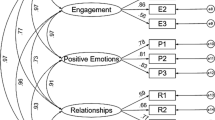Abstract
The present study is a correlational field study because the purpose of this study is to ascertain the nature of relationship between Anasakti and adjustment. Anasakti, the concept of Bhagavad Gita, refers to an intense though disinterested action, performed with a spirit of passion, without nurturing concerns regarding success or failure, loss or gain, likes or dislikes. The present study is conducted on 291 Hindu graduate adults in the age range of 45–65 years. Incidental-cum-purposive sampling technique is used for data collection. A positive correlation is found between Anasakti and adjustment. The study reveals that if Anasakti increases then adjustment level also increases.
Similar content being viewed by others
References
Bhave, V. (1974). Talks on the Gita. Varanasi: Sarva Seve Sangh Prakashan.
Edgerton, F. (1965). The beginnings of Indian philosophy. London: George Allen & Unwin.
Hussain, S. & Kaur, J. (1995). Shamshad-Jasbir old-age adjustment inventory (SJOAI): National Psychological Corporation, Agra.
Jha, M.K. (2002). Certain Psychological Correlates of Asakti—Anasakti (Ph.D. Thesis): T.M. Bhagalpur University, Bhagalpur.
Lazarus, R. S. (1976). Patterns of adjustment. Tokyo: MeGrawHill Koga Kusha, Ltd.
Lehner, G.F.J. & Kube, E. (1964). The Dynamics of Personal Adjustment: Prentice-Hall Psychology series, The Universtity of Michigan.
Pandey, N., & Naidu, R. K. (1992). Anasakti and health: A study of non-attachment. Psychology and Developing Societies. 4(1), 89–104.
Paranjpe, A. (1984). Theoretical psychology: Meeting of the east and west. New York: Plenum Press.
Pareek, U. (1981). A survey of research in psychology: 1971–1976, Part 2. Bombay: Popular Prakashan.
Rama, S. (1996). Perennial psychology of the Bhagavad Gita. Honesdale, PA: The Himalayan International Institute of Yogic Science & Philosophy of the USA.
Rao, S. K. R. (1962). Development of psychological thought in India: Kavyalaya Publishers, 1st Ed.
Salsman, J. M., Brown, T. L., Brechting, E. H., & Carlson, C. R. (2005). The link between religion and spirituality and psychological adjustment: The mediating role of optimism and social support. Personality and Social Psychology Bulletin, 31(4), 522–535.
Shaffer, L. F., & Shoben, E.J., Jr (1956). The psychology of adjustment. Boston: Houghton Miffin Company.
Young, J. Scott, Cashwell, C. S., & Shcherbakova, J. (2011). The moderating relationship of spirituality on negative life events and psychological adjustment. Counselling and Values, 45, 49–57.
Author information
Authors and Affiliations
Corresponding author
Rights and permissions
About this article
Cite this article
Agrawal, S. Anasakti and Adjustment. J. Indian Counc. Philos. Res. 36, 39–51 (2019). https://doi.org/10.1007/s40961-018-0155-9
Received:
Revised:
Accepted:
Published:
Issue Date:
DOI: https://doi.org/10.1007/s40961-018-0155-9




